November 30, 2022 – Volume 24, Issue 11
In This Issue
- Flanigan’s Eco-Logic: Copenhagen’s Leadership
- Wooden Wind Blades and Towers
- First V2G Utility Export Rates
- Tariff On-Bill Financing
- EU Countries Pushing for 100%
- Scaling Offshore Floating Wind Farms
- French Solar Mandate
- Iron Flow Batteries for Sacramento
- World’s First CO2 Battery
- South Australia: Refining 100% Renewable
- Flanigan’s Ego-Logic Podcast Updates
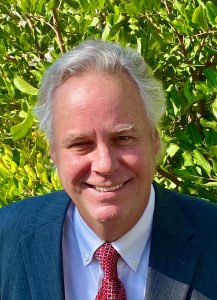
Flanigan’s Eco-Logic: Copenhagen’s Leadership
Proud of my Danish roots… the Markussons there. Love Copenhagen… the bicycle city. Proud to have worked for ICLEI on Copenhagen’s earliest climate works. Now this: A new community in Copenhagen called UN17 is being designed to meet every one of the United Nations’ 17 Sustainable Development Goals (SDGs). The community is certainly refining sustainability in architecture.

Image Courtesy of Sweco Architects
Martin Schultz Nielsen is the investment director of NREP, the company behind the project called UN17. It consists of five buildings that will house 1,100 residents. UN17 is being built on city-owned land in a new neighborhood called Orestad, south of the Copenhagen city center.
The 2030 Agenda for Sustainable Development, adopted by all United Nations Member States in 2015, provides a shared blueprint for peace and prosperity for the people and the planet. At its heart are 17 Sustainable Development Goals. They call for urgent action by all countries – developed and developing – in a global partnership.
Here are the 17 ESGs: 1. No Poverty, 2. Zero Hunger, 3. Good Health and Well-Being, 4. Quality Education, 5. Gender Equality, 6. Clean Water and Sanitation, 7. Affordable and Clean Energy, 8. Decent Work and Economic Growth, 9. Industry, Innovation, and Infrastructure, 10. Reduced Inequalities, 11. Sustainable Cities and Communities, 12. Responsible Consumption and Production, 13. Climate Action, 14. Life Below Water, 15. Life on Land, 16. Peace, Justice, and Strong Institutions, 17. Partnerships for the Goals.
Goal #1 is No Poverty. UN17’s developers are committed to affordable rent. The community also includes a sharing center where neighbors will be able to donate or borrow items and use a shared workshop to repair bikes or furniture. Good Health and Well-Being is Goal #3. UN17 is designed to get residents to walk more, to enjoy meeting neighbors in the community gardens. It includes healthy cooking classes.
Then there’s better ventilation and lots of natural light. The apartments are designed to minimize noise to promote better sleep. There is a 550-acre nature preserve next to the site, and the community’s design is intentional in nudging people outdoors to experience biodiversity. The design concept is that when residents and guests are there, or residents are at home, they will feel like they are in nature, not next to it. Meeting Goal #14 relates to protecting the world’s oceans. The developers used materials from recycled fish nets, and avoided using other material that could pollute the water. Goal #17 is Promote Sustainable Cities. This is easily met with bike promotion and access.
The community’s architecture is complemented by intentional social design. There will be group meals, and lots of volunteering opportunities. The diversity of age groups among residents is intentional. Its designers are clear that young families love having elderly neighbors, and the elderly feel good being around children and their growing families. Low-carbon construction is achieved through increased use of wood and limited cement. Solar panels abound. The roofs and courtyards collect water for irrigation. Green spaces support wildlife like deer and pheasants. UN17 is in its final stages of construction.
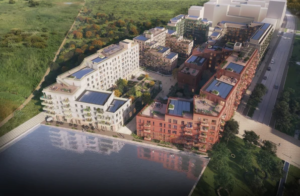
Image Courtesy of Sweco Architects
Quote of the Week
“Every rooftop in America that isn’t producing solar energy is a rooftop wasted as we work to break out dependence on fossil fuels and the geopolitical conflicts that come with them. Now is the time to lean into local renewable energy production, and there’s no better place than the roofs of America’s big-box superstores.”
Johanna Neumann
Senior Director of the 100% Renewable Campaign Environment America
Wooden Wind Blades and Towers
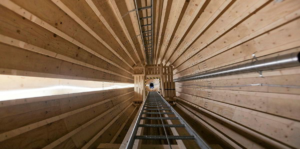
Image Courtesy of Modvion
Finnish renewable product maker, Stora Enso, is one of the largest private forest owners in the world. It has recently partnered with German start-up, Voodin Blade Technology, to make sustainable wooden wind turbine blades. The two companies are producing 66-foot blades that will be put into test operation near Warburg, Germany. The companies are planning to also make a 262-foot blade.
The blades are made with Laminated Veneer Lumber (LVL). They are lighter than conventional blades, making them easier to transport and erect. LVL is a “mass timber product” that has a high load-bearing capacity, giving the blades great strength, all with less carbon footprint.
Stora Enso has also established a partnership with a Swedish wood technology company – Modvion – to promote wood as the material of choice for wind turbine towers. Modvion erected its first wooden wind turbine tower on an island outside of Gothenburg in May of 2020. The LVL towers are modular. The wood is lighter than steel and as a result the towers can be built taller… which means access to stronger winds. Modvion is now under contract with Vestas to supply 200 wooden towers.
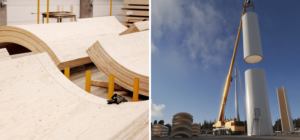
Image Courtesy of Modvion
First V2G Utility Export Rates
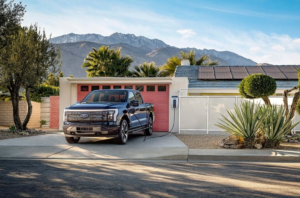
Image Courtesy of Ford Motors
Northern California’s massive utility, Pacific Gas and Electric (PG&E), has been given regulatory approval to establish the first export rates for vehicle to grid programs. What? Let’s back up!
Electric vehicles have battery packs that often have excess energy stored that could support electricity grids during periods of peak demand. Instead of simply using EV chargers to draw from the grid, in the future they will be set up to receive the power that we send from our EVs. More than 420,000 electric vehicles have been sold in PG&E’s service territory, one of six EVs in the country. That’s a lot of battery energy storage.
Soon these EVs will be able to send power back to the grid, earning cash or credits for doing so. This is known as Vehicle to Grid (V2G) and now also VGI, Vehicle Grid Integration. The news is that we now have a utility providing a value for the power returned to the grid. The price will vary depending on the utility’s need. It will be a “dynamic export rate.”
This nation’s first V2G “export compensation mechanism” was adopted by the California Public Utilities Commission on October 20, 2022 thanks to PG&E. The rate is expected to increase participation for V2G school buses and other electric vehicles in response to near real-time grid conditions, and in turn for buses and fleet vehicles – and later cars – to serve as flexible grid resources. Together, they will support a more reliable, affordable and efficient energy system.
Tariff On-Bill Financing
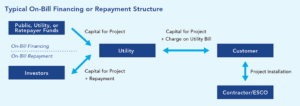
Tariff On-Bill Financing (TOBF) is a new means for utility customers to pay back the cost of efficiency upgrades and solar installations without credit or income level conditions. Most use of TOBF has been for energy efficiency upgrades. TOBF has also been used by utilities to finance solar installations for low and moderate-income households.
Hawaiian Electric Companies uses TOBF for low and moderate-income customers to pay back the cost of installing solar PV, solar water heaters, and other eligible upgrades with no upfront cost. The program is funded by Hawaii’s Green Bank. Utilities provide the capital for the asset, customers pay back through a tariff, a slight nuance to the “charge on the utility bill” in the graphic above. The tariff is added to a participant’s electricity bill. Ideally, the reduced electricity use will result in a lower utility bill, net of the tariff.
Because customers repay through a tariff, it’s not technically a loan. Thus a customer’s credit and income level are not program eligibility limitations. Furthermore, the asset is tied to the home, and specifically to its meter, and so if the home is sold and ownership is transferred, the tariff stays with the meter.
PAYS is a trademarked program that serves utilities for TOBF implementation. Roanoke Electric Cooperative, for example, uses the PAYS model to implement TOBF. Grand Valley Power uses TOBF to finance community solar. Participants sign up for 4-year subscriptions with no upfront costs, and then they pay a tariff of 2 cents/kWh to cover the net program costs in exchange for the community solar bill credits.
EU Countries Pushing for 100%

Image Courtesy of European Commission
War in the Ukraine has shown the world and especially the European Union the danger of heavy reliance on imported fuels. Russian oil is short and tainted, and has been plentiful in Europe. Not any more.
In response, the European Union as a bloc has a goal to reach 82% clean energy by 2030. A handful of EU nations are pushing even harder, accelerating their prior goals and the EU phase out. They are aiming to reach 100% renewable by 2030.
Denmark, in response to war in Ukraine, plans to phase out natural gas entirely and to quadruple production of solar and wind. By 2030, Denmark plans for 100% renewable power. It also has its sights on becoming a renewable energy exporter.
In 2021, the Austrian National Parliament introduced the Renewable Energy Sources Expansion Act which set the goal for Austria to be 100% renewable powered by 2030.
Portugal announced in April that it is accelerating its energy transition, increasing the production of renewable energy resources to 80% by 2026, four years earlier than planned. It already gets 60% from renewables, one of the highest amounts in Europe. Note that Portugal does not rely on gas from Russia, instead importing gas largely from Algeria and Nigeria. Portugal became coal-free in 2021. The county’s largest utility, EDP, is planning to provide 100% renewable energy by 2030.
Some say that The Netherlands is leading Europe’s energy transition to clean energy. Its offshore wind production is set to double by the end of the decade. The Netherlands has a goal of 150 GW of North Sea wind generation by 2050. The country is committed to 100% clean energy by 2030, but this year had to revert to coal use given natural gas shortages.
Scaling Offshore Floating Wind Farms
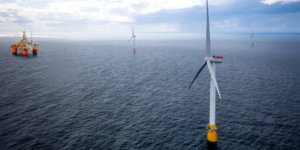
Image Courtesy of Hywind Tampen
So far the biggest offshore floating wind farm in the world is the 47.5 MW Kincardine wind farm. It is ~10 miles off the coast of Aberdeenshire, Scotland and is now fully operational. It first produced power in 2018. There, five Windfloat units each produce 9.5 MW of power.
But hang on, floating wind farms are scaling rapidly. Why? The technology has quickly advanced, the costs are coming down. In the United States, two-thirds of the offshore wind potential exists over waters too deep for fixed-bottom, wind turbine foundations that are secured directly to the sea floor. Experts suggest that 80% of the world’s offshore wind potential is in deep waters. Now semi-submersible platforms allow for development of floating wind turbines in these areas.
The Hywind Tampen floating offshore wind project, 87 miles off the Norwegian coast in the Tampen area of the Norwegian North Sea, will soon take the mantle as the largest floating facility: The first power has been produced in what will be a 88 MW project when complete. Power will supply electricity to oil and gas platforms. The first Hywind power is being used for the Gullfaks A platform.
The entire wind farm was slated for completion in 2022, but deviations in steel quality of turbine tower sections have delayed the project. Even with only 7 of planned 11 turbines, the farm will be the world’s largest at 60 MW. Ultimately, the project will meet 35% of the electricity needs of the Gullfaks and Snorre oil and gas fields. Its 11 turbines will cut greenhouse gas emissions there by 200,000 tonnes per year.
“Whelp, that was fast,” noted a CleanTechnica reporter on the world’s largest floating wind farms. “The world’s latest floating offshore wind array clocked in at 88 MW just last week, and here comes another one more than 10 times its size.”
The proposed Nao Victoria offshore wind farm will bring 990 megawatt’s worth of floating wind turbines to Spain, off the coast of Malaga and Cadiz. The Nao Victoria wind farm plan is to install 55 floating wind turbines, 18 MW each in size and located in an area that will cover 120 square miles, 15 – 25 miles offshore “to minimize impacts on the seascape from shore.”
Why floating? Floaters allow for wind development in deeper waters where fixed-platform turbine platforms are impractical. A U.S. Department of Energy study earlier in 2022 tallied up 60,746 MW of floating turbine projects around the world, almost all in the pipeline awaiting construction. There are less than 200 MW in operation. However, floating wind turbine costs are rapidly sinking. Vestas will now install 15 MW floaters off of South Korea. The DOE has launched the Floating Offshore Wind Initiative under its Energy Earthshots program, aimed at slashing costs to $45/MWh by 2035, 70% less than current levels.
French Solar Mandate
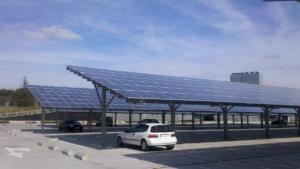
France now requires that solar roofs are installed on all parking lots throughout the country. In Europe, these are often called “car parks.” As part of the push across Europe to replace natural gas supplies from Russia, the French government has taken bold steps. “We must not delay the implementation of the decarbonization of our economy,” noted French Senator Agnes Pannier-Runacher, as reported by Forbes. The French government’s initiative to cut energy use includes a communications theme, “Every Gesture Counts,” a campaign that encourages individuals and industries to cut energy use.
The French solar mandate requires all car parks with space for more than 80 cars to cover those spaces with solar roofs. The car park owners will have five years to comply. Lots with more than 400 spaces will have only three years to comply. Failure to comply will result in 50 Euros per parking spot per month. For a lot with 800 spaces, this could amount to some 48,000 Euros per year. Car parks that have architectural, environmental, heritage, or other proven restraints, and car parks that have at least half of the property shaded by trees, may be exempt.
Many French parking lots already have solar. At Disneyland Paris, there is ongoing development of a 17 MW solar installation that will ultimately cover 11,200 parking spots with solar arrays.
Iron Flow Batteries for Sacramento
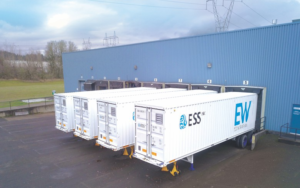
Image Courtesy of ESS Inc.
The City of Sacramento, home to California’s second largest municipal utility, the Sacramento Municipal Utility District (SMUD), is placing a big order on flow batteries, fully 200 MW / 2 GWh of energy storage. Unlike solid-state, lithium-ion batteries, these batteries operate by flowing an electrolyte across a membrane. They have several advantages: They discharge for long periods of time. They are non-corrosive and non-toxic.
The batteries that are being purchased from ESS use an iron-flow technology. ESS claims that, “Thanks to food-grade, earth-abundant iron, salt and water, for the electrolyte, ESS batteries are easiest to sight and safest to operate.” They do not use rare earth materials. Unlike batteries that have limited cycles, the ESS iron flow chemistry lasts for 20 years or more, its performance insured by Munich Re.
SMUD is committed to eliminating its carbon emissions by 2030, well ahead of California’s 2045 deadline. Energy storage is an important element of the plan. SMUD’s master supply agreement with ESS will result in the delivery of several megawatts in the next 18 months, followed by tens of megawatts in the second phase, and up to 100 MW in the third phase.
The iron flow battery technology is not new. The batteries store electricity in a liquid electrolyte containing dissolved iron. Advocates have been trying to make the case that the technology is superior. At last, flow batteries are gaining favor. The ESS contract with SMUD is a big step.
World’s First CO2 Battery
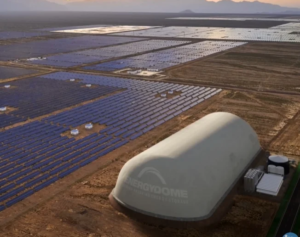
Image Courtesy of Energy Dome
Italian startup, Energy Dome, is the maker of the world’s first CO2 battery. It uses carbon dioxide to store energy from excess wind and solar power. This battery chemistry is a bit ironic as CO2 is the leading climate culprit. Now it is being used for long duration energy storage to shore up intermittent renewable energy to combat climate change.
Energy Dome began operations in 2020. It was awarded funding from Hawaii and San Francisco Bay-area based group, Elemental Excelerator. It invests in “climate deployment” and its leaders project a huge demand for long duration energy storage.
Energy Dome has progressed from concept to multi-megawatt scale in just over two years. It developed its first battery in an industrial area in Sardinia. The test facility stored 4 MWh. Now the first commercial plant is planned for operation in 2024. It will store 200 MWh to dispatch over a period of up to 24 hours.
The technology uses carbon dioxide to store energy in the form of pressure and heat. Here’s how it works: CO2 is one of the few gasses that can be condensed and stored as a liquid under pressure at ambient temperature.
So to charge the battery, CO2 that is stored in a giant bladder at atmospheric temperature, is compressed using excess wind and solar power. The heat that is generated during compression is stored. When the heat is removed, the CO2 gas becomes a liquid. To generate electricity when needed, the liquid CO2 is heated up using stored heat, and converted back to a gas that powers a turbine, which generates power. The CO2 gas is always contained and the entire system is sealed in a closed loop. Put another way, CO2 stores energy cost-effectively in a closed thermodynamic process.
South Australia: Refining 100% Renewable
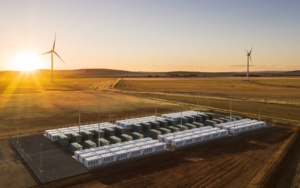
Image Courtesy of Neoen
South Australia is poised to become the first power grid of its size to operate without synchronous, gas-fired generation. What’s that? Grids have relied on generators to provide “grid forming” services… complex electrical engineering that keeps our grids stable and synchronous. Removing grid-forming services heretofore provided by gas generators is seen as a compelling final step on the path to 100% renewables.
Within the next few years, according to a new planning document from the South Australia market operator, gas generators may be redundant to services that can be provided by batteries. Until now, and even with full saturation of wind and solar, the utility has been required to operate four synchronous, gas-fired generators.
South Australia is a world leader in penetration of wind and solar. These renewables provided 64% of power consumption over the last 12 months. There are times when wind and solar produce more than 100% of the State’s demand. A new record of 146% of peak was achieved from wind only on a week-day morning. Excess power is exported to Victoria via transmission links. Even during these periods, gas-fired generation has been required to maintain the system frequency.
Fortunately there has been growing confidence in battery and inverter technologies. Last year, the regulatory requirement for this synchronicity was reduced from four generators to two generators. Four synchronous condensers – motors that simply spin when needed, but that do not generate power – were added to the system as grid stabilizers.
“Grid forming” and “grid reference” are two qualities that can now be provided by batteries, technically by “grid forming inverters.” They are now deployed at two South Australian battery sites, Dalrymple North and Hornsdale. And synchronous generation, previously done with generators, may not be required for grid reference. The grid-following inverter “latches on” to the voltage waveform supplied by the synchronous condensers.
South Australia is leading the charge to no fossil fuels, now in terms of synchronous generation. This techie article is about the last quibbles about whether a grid is truly 100% renewable or not. It is based on an article published by Renew Economy.
Flanigan’s Ego-Logic Podcast Updates
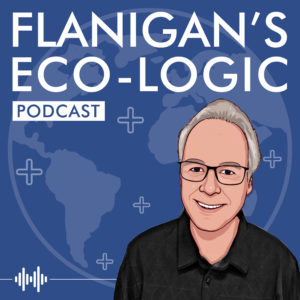
Use the links below to check out our recent podcasts. And you can always simply go to Spotify and type in Ted Flanigan to find our library of nearly 100 podcasts.
Recently Released:
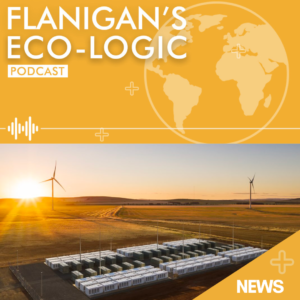
This issue of EcoNet News, Volume 24, Issue #11 is also available in podcast format. It includes battery chemistry developments, updates on offshore wind’s “floaters,” the European Union’s renewed commitments to clean energy, utility issues related to Vehicle to Grid export tariffs and Tariff On-Bill Financing, and a Danish manifestation of sustainable development.

Mark Jacobson is a Professor of Civil and Environmental Engineering at Stanford University and Director of its Atmosphere/Energy Program. He is also a Co-Founder of the non-profit, Solutions Project. He discusses his early concerns about air pollution, then a distinguished academic career which started with engineering at Stanford and atmospheric science at UCLA.
Mark is a prolific researcher. He was a pioneer in air quality monitoring. He co-founded Climate Solutions, a consortium of business leaders, actors, and scientists working together to present WWS (wind, water, and solar) solutions for cities globally. He has been featured on TED Talks and was a guest on the Late Show with David Letterman. He shares his optimistic view on better understanding air pollution and global warming problems, and developing large-scale clean, renewable energy solutions for them.
